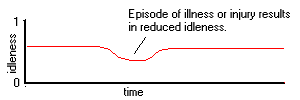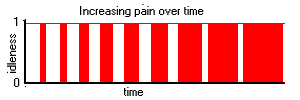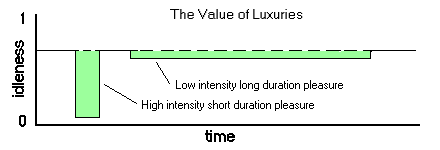
Idle Theory's ethics and economics may be thought of as a variant of Utilitarianism in which 'happiness' has been replaced by 'idleness', and in which the benefits and costs consequent upon any action are measured in gains and losses of idle time, and in which the 'right' course of action is the one which maximizes idleness, or minimizes busyness or work.
This is a variant of Utilitarianism from which subjective valuations have been driven, and in which objective value is measured in time spent idle.
However, it may be possible to move Idle Theory closer to Utilitarianism by explaining pain and pleasure in the terminology of Idle Theory.
Pain
In Idle Theory, living things alternate between busy and idle states. Busy periods are spent working to maintain life. Work requires mental attention to some activity and, usually, some amount of physical work. Someone who is digging a ditch performs physical work as they lift and throw soil from a trench. But someone who is digging a ditch must also devote most of their attention to this task, deciding where to dig next, where to throw the soil, and so on.
The human body is always performing physical work, as its heart beats and drives blood through veins, and as lungs inhale and exhale, and body muscles maintain body posture, and as the various organs of the body perform their functions, and as every single cell repairs and reproduces itself. But almost all this physical work does not entail any conscious control and direction, but proceeds automatically, and so this work does not count as 'busy' time in Idle Theory.
Equally, when someone is playing a game of tennis, their body performs physical work, running and jumping, and their attention is devoted to the game, following the ball, deciding what shot to play, and so on. But this does not count as being 'busy' in Idle Theory because games of tennis are not activities which humans need to do perform in order to stay alive, but which they engage in because they enjoy playing such games.
Physical Pain
For the most part, when humans perform work, they choose what work they will do, and when they will do it. Most work is voluntary, at least in the sense that people can to some extent choose when to do it. Pain, by contrast, may be thought of as involuntary work. Pain is a kind of inescapable busyness. Pain demands immediate action to bring relief from the source of pain. A broken limb, aching and throbbing, draws attention to itself, demanding relief.
Physical pain of this sort interrupts whatever activity is being otherwise engaged upon, drawing attention to itself, and demanding immediate action. And what applies to burned fingers applies also to thumping headaches and aching limbs, and every other sort of physical pain.
The experience of the pain of a burned finger or a stubbed toe is of a few seconds of intense pain which corresponds to a few seconds of busy attention to that pain. A thumping headache, by contrast, entails the repeated interruption of consciousness.
Since such pains interrupt and dominate consciousness, it means that people who are in such intermittent pain are intermittently disabled from doing any work, or enjoying any other activity. Someone who has a thumping headache which, for example, interrupts them for half a second every five seconds suffers a 10% reduction in idleness, and can only perform useful work or enjoy some other activity for 90% of the time they are idle, or not in pain. Pain is disabling, and bouts of pain are superimposed upon idle pleasures and busy work as negations of those activities.
If someone in good physical health has an idleness of 50% - which means that they must spend half their time working to maintain thmselves - then if they suffer from some intermittent pain that prevents them from working 10% of the time, or from enjoying their leisure for 10% of the time, then their idleness falls from 50% to 40%, and perhaps even more. Their work takes longer to do, and their idle time is reduced. A painful and debilitating illness entails a decrease in idleness, and the recovery of good health entails a rise in idleness. Idleness may fall during illness either because pain directly prevents work, or because painless disability or weakness slows work.
prevents them from working 10% of the time, or from enjoying their leisure for 10% of the time, then their idleness falls from 50% to 40%, and perhaps even more. Their work takes longer to do, and their idle time is reduced. A painful and debilitating illness entails a decrease in idleness, and the recovery of good health entails a rise in idleness. Idleness may fall during illness either because pain directly prevents work, or because painless disability or weakness slows work.
If, during bouts of pain, conscious attention is always being diverted to the source of pain, then as pain becomes more intense (as when a headache gets worse) less and less attention can be devoted to doing anything else. And at the extreme of pain complete unconsciousness may result, as attention is entirely devoted to interruptive pain, and no idle time is available to attend to anything else. In the diagram at right, increasing pain is shown as increasingly long intervals of time spent in pain at zero idleness (red) interrupting idle intervals (white).
as attention is entirely devoted to interruptive pain, and no idle time is available to attend to anything else. In the diagram at right, increasing pain is shown as increasingly long intervals of time spent in pain at zero idleness (red) interrupting idle intervals (white).
The intensity of any pain then corresponds to the proportion of time that is spent busy in pain, or 'busyness'. No pain corresponds to zero busyness, and mild pain corresponds to some low level of busyness, and the maximum of pain is unit or complete busyness.
The character of any pain is most likely a function of its frequency. A 'sharp' pain is probably a predominantly high frequency pain, like a high musical note, and a 'dull' pain is probably a predominantly low frequency pain.
Pain often performs a regulatory role. The pangs of hunger and of cold act as prompts to find food and shelter. The motor skills of running and walking are learned through making many painful mistakes. In this sense an ability to feel pain is important for wellbeing.
Psychological Pain
If physical pain entails the interruption of conscious activity to draw attention to a source of physical pain, psychological pain may be thought of as the interruption of conscious thought by some other thought. Soomeone may find themselves thinking about something all the time, and find it difficult to focus their attention on anything else. And so the heartbroken thinks about his lost love all the time, and trying to find away to alleviate the 'pain' of loss.
Psychological pain - the continual interruption of conscious thought by some other, obsessive idea - may sometimes be as debilitating as physical pain, perhaps even to the point of unconsciousness.
Psychological pain may be 'all in the mind' in that it arises in the human mind and is experienced in the human mind, while physical pain arises in the body and is experienced in the mind as 'physical' pain, but that does not make psychological pain any less 'real' than physical pain. The 'pain' of a 'broken heart' is as real as the pain of burnt finger or a stubbed toe. It simply arises from different causes, and is experienced in different ways.
Pain, in this approach, is simply a form of work. Like work, it demands attention and action. And like work, it is not something that people choose to engage in, but which is obligatory and therefore choiceless.
Pleasure
Idle time is time during which people can choose what they do. In their idle time, people can very largely do as they please. And therefore idle time has the nature of pleasure.
If pain is measured in degrees of busyness, pleasure may be measured in degrees of idleness. And since busyness is the mathematical complement of idleness (busyness = 1 - idleness), it follows that pleasure decreases as pain increases, and vice versa.
In Bentham's Utilitarian felicific calculus pleasures had intensity, duration, certainty, propinquity, fecundity, purity, and extent.
The duration of pleasure is the duration of idle time. Its certainty is the probability of it happening. Its propinquity is its nearness in time. Its purity is the degree to which it is not accompanied by pain. Its extent is concerned with how many people enjoy it. Its fecundity is the degree to which it brings new pleasures.
The intensity of a pleasure might be thought of as the closeness of attention to the object of pleasure. The experience of watching a 'gripping' movie is one of giving it one's undivided attention, ignoring everything else. An engrossing novel or a thrilling movie may completely absorb someone to the exclusion of everything else. But the enjoyment of a painting or a sculpture or an ornamental garden is generally an occasional pleasure spread over years or even decades. If watching a thriller entails devoting rapt attention to it for a couple of hours, and the enjoyment of a garden entails intermittent attention to it over several years, it may be that Benthamite 'intensity' roughly corresponds to the rate at which idle time is devoted to some activity, ranging from total concentration to intermittent mild interest.

In anyone's idle time, their attention may not focus on anything, but drift from one thing to another. The experience of boredom might be thought of as such a lack of attention to anything in particular. The devotion of attention to some activity - talking, playing cards, reading books, watching movies, etc. - provides a focus of attention. When these become uninteresting, attention drifts elsewhere. A movie has become 'boring' when one begins to notice the back of the head of the person sitting in the seat in front.
This does not mean that the most intense pleasures are always ones in which complete attention is devoted to a single activity. A dinner party may be intensely pleasurable for the quality of its food and drink, the quality of the conversation that flows between mouthfuls of food, and for the attraction between individuals, and perhaps also for any music that may be playing at the same time. In this case, complete attention passes from one thing to another in succession.
Painful Pleasures and Pleasurable Pains
Self-maintenance work earning a living is obligatory work, and what is obligatory is not freely chosen. Someone who is doing such necessary work is not doing as they please, but as their circumstances dictate. And so such work inherently has the nature of pain rather than pleasure, because it is an imposition rather than a choice.
Nevertheless, a great many people actively enjoy the occupations by which they earn their living. Woodcutters may enjoy chopping down trees, and cobblers enjoy making shoes, and so on, sometimes even to the point of declaring that "I'd do it even if I wasn't paid."
In these cases, people are 'choosing' to do what they anyway must do. They are willingly throwing themselves into doing what they have to do.
Work very often allows a great deal of latitude about when it is done and where it is done and how it is done. The woodcutter who spends his days cutting down trees may choose which trees he will fell, and whether he will fell them in the morning or the afternoon, and whether he will use an axe or a saw, and so on. There may be wide scope for choice in work, even though the work overall is choiceless. And to the extent that people can choose how and when they do their work, to that extent they are likely to enjoy their work. The less choice there is about work, the more it becomes a rote mechanical activity, the more 'soul-destroying' it becomes.
To the extent that people willingly do what they must do, and throw themselves wholeheartedly into doing it, to that extent they will find (q.v.) that working hours pass rapidly. But to the extent that people come to enjoy their work, they may also tend to resist improvements. The woodcutter who enjoys swinging an axe may not enjoy using a chain saw, because it spoils the pleasure, even if it does the job more quickly.
And if necessary and compulsory work can often be enjoyable, then freely chosen pastimes may often not be at all enjoyable. One may not enjoy the movie one is watching, or the food at a dinner party, or the conversation around it, or the music playing. What has been chosen may become constraining. It is perfectly possible that someone take great pleaure in their work, but take very little pleasure in their leisure activities.
But for the most part, people prefer leisure to work, and thus prefer to be free to choose what they do rather than to be constrained.
The Subjective Experience of Time
The subjective experience of time often varies with the intensity to which attention is devoted to any activity, with the most intense concentration resulting in time seeming to pass rapidly, while time 'hangs heavy' or 'drags' when attention is not devoted to anything. When people 'kill time' by playing cards or doing crossword puzzles, the attention they devote to these activities results in time seeming to go by more quickly.
The same also applies to the performing of work. Someone who works diligently and attentively will find that their work is completed quickly, while time passes infinitely slowly if they allow their attention to drift elsewhere.
One simple explanation of this is that people can only watch clocks, and thus note the passage of time, to the extent that their attention is not devoted to some activity. Busy people only occasionally glance at the clock, and so its hands have usually moved on far further each time they look than if they glanced at it in boredom every few seconds. It does not matter if there is no actual clock to watch, because people have a natural 'sense' of the passage of time, if only as internally measured by heartbeats or breathing.
Watching events unfold in 'real time' in the world with rapt attention might be equivalent to watching the second hand of a clock. And so someone who is in a car crash or other accident, to which they are devoting their undivided attention as it happens, may recollect the experience as 'the longest few seconds in my life' because what they were doing was the equivalent of watching the second hand of a clock with rapt attention.
The experience of sleep is generally one of time passing rapidly. One seems to wake up very shortly after one fell asleep, not having noticed the passage of 7 hours. But a wakeful night of interrupted or broken sleep seems to pass very slowly. Again this may be explained as not 'watching the clock' during sound sleep, but watching the clock all the time during a sleepless night.
What applies to intense pleasure may also apply to intense pain. Intense pain that results in unconsciousness may also result in time seeming to pass very rapidly. Intense pain, like intense pleasure, is generally fleeting.
Summary
It has been suggested here that pain is a form of interruptive and involuntary work, and is work that is superimposed upon other activities, negating them. The intensity of pain is measured by busyness, which can vary from 0 (no pain) to 1 (the most intense pain). Interruptive pain is usually physical in origin, but may also be psychological in origin.
Pleasure is found in idle time activities, which are freely chosen, and consequently pleasant. The intensity of a pleasure is the degree to which attention is devoted to an idle pastime.
Pain and pleasure are complementary. As one increases, the other decreases.
There is undoubtedly far more that can be said about both pain and pleasure. The pleasure of winning a bet on a race, or the pain of losing it, are entirely psychological in nature, and have little to do with how busy or how idle anyone may be. But this brief discussion of pain and pleasure may help to clarify Idle Theory's approach to simple pains and pleasures, and perhaps at the same time align it more closely with its Utilitarian precursors.
